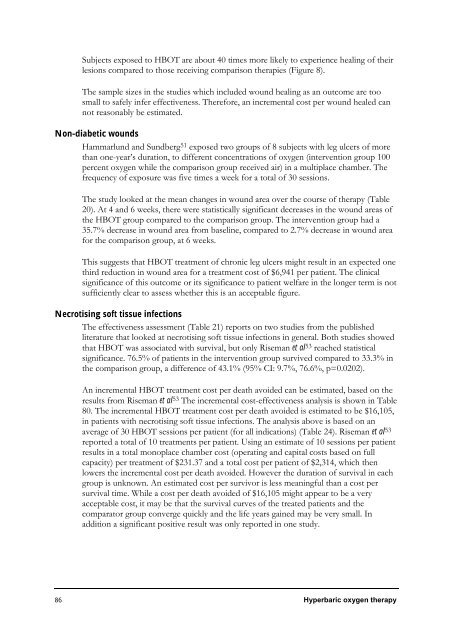Hyperbaric Oxygen Therapy - Hyperbaric Chamber Information ...
Hyperbaric Oxygen Therapy - Hyperbaric Chamber Information ...
Hyperbaric Oxygen Therapy - Hyperbaric Chamber Information ...
Create successful ePaper yourself
Turn your PDF publications into a flip-book with our unique Google optimized e-Paper software.
Subjects exposed to HBOT are about 40 times more likely to experience healing of their<br />
lesions compared to those receiving comparison therapies (Figure 8).<br />
The sample sizes in the studies which included wound healing as an outcome are too<br />
small to safely infer effectiveness. Therefore, an incremental cost per wound healed can<br />
not reasonably be estimated.<br />
Non-diabetic wounds<br />
Hammarlund and Sundberg 51 exposed two groups of 8 subjects with leg ulcers of more<br />
than one-year’s duration, to different concentrations of oxygen (intervention group 100<br />
percent oxygen while the comparison group received air) in a multiplace chamber. The<br />
frequency of exposure was five times a week for a total of 30 sessions.<br />
The study looked at the mean changes in wound area over the course of therapy (Table<br />
20). At 4 and 6 weeks, there were statistically significant decreases in the wound areas of<br />
the HBOT group compared to the comparison group. The intervention group had a<br />
35.7% decrease in wound area from baseline, compared to 2.7% decrease in wound area<br />
for the comparison group, at 6 weeks.<br />
This suggests that HBOT treatment of chronic leg ulcers might result in an expected one<br />
third reduction in wound area for a treatment cost of $6,941 per patient. The clinical<br />
significance of this outcome or its significance to patient welfare in the longer term is not<br />
sufficiently clear to assess whether this is an acceptable figure.<br />
Necrotising soft tissue infections<br />
The effectiveness assessment (Table 21) reports on two studies from the published<br />
literature that looked at necrotising soft tissue infections in general. Both studies showed<br />
that HBOT was associated with survival, but only Riseman et al 53 reached statistical<br />
significance. 76.5% of patients in the intervention group survived compared to 33.3% in<br />
the comparison group, a difference of 43.1% (95% CI: 9.7%, 76.6%, p=0.0202).<br />
An incremental HBOT treatment cost per death avoided can be estimated, based on the<br />
results from Riseman et al 53 The incremental cost-effectiveness analysis is shown in Table<br />
80. The incremental HBOT treatment cost per death avoided is estimated to be $16,105,<br />
in patients with necrotising soft tissue infections. The analysis above is based on an<br />
average of 30 HBOT sessions per patient (for all indications) (Table 24). Riseman et al 53<br />
reported a total of 10 treatments per patient. Using an estimate of 10 sessions per patient<br />
results in a total monoplace chamber cost (operating and capital costs based on full<br />
capacity) per treatment of $231.37 and a total cost per patient of $2,314, which then<br />
lowers the incremental cost per death avoided. However the duration of survival in each<br />
group is unknown. An estimated cost per survivor is less meaningful than a cost per<br />
survival time. While a cost per death avoided of $16,105 might appear to be a very<br />
acceptable cost, it may be that the survival curves of the treated patients and the<br />
comparator group converge quickly and the life years gained may be very small. In<br />
addition a significant positive result was only reported in one study.<br />
86 <strong>Hyperbaric</strong> oxygen therapy



